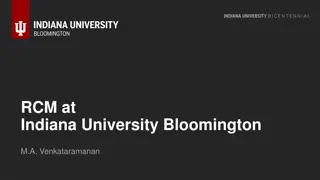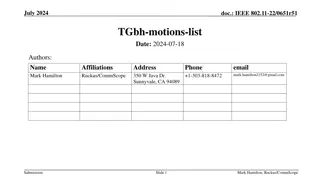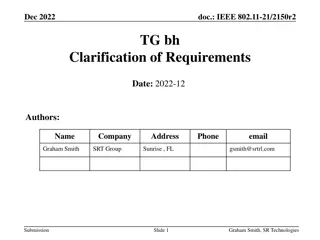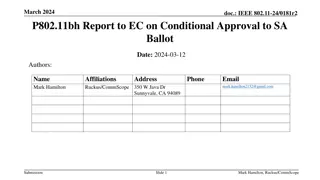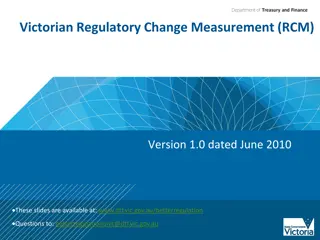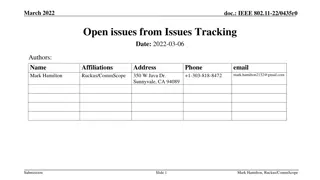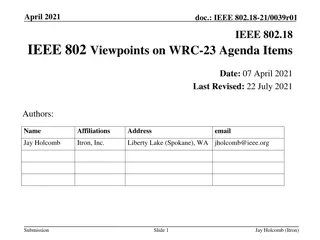IEEE 802.11bh Overview: RCM and TGbh Activities
Overview of IEEE 802.11 Task Group bh (TGbh) activities related to Randomized and Changing MAC addresses (RCM) for user privacy protection. The document discusses the purpose of RCM in concealing device identities, potential impact on network recognition and user experience, and the evolution of IEEE Std. 802.11 to adapt for RCM. It also outlines the work organization, status, use cases, and applicability of RCM in various network scenarios.
Download Presentation

Please find below an Image/Link to download the presentation.
The content on the website is provided AS IS for your information and personal use only. It may not be sold, licensed, or shared on other websites without obtaining consent from the author.If you encounter any issues during the download, it is possible that the publisher has removed the file from their server.
You are allowed to download the files provided on this website for personal or commercial use, subject to the condition that they are used lawfully. All files are the property of their respective owners.
The content on the website is provided AS IS for your information and personal use only. It may not be sold, licensed, or shared on other websites without obtaining consent from the author.
E N D
Presentation Transcript
January 2022 doc.: IEEE 802.11-22/0057r0 802-Technical-Plenary-802.11-TGbh-overview Date: 2022-01-11 Authors: Name Mark Hamilton Affiliations Ruckus/CommScope Address 350 W Java Dr. Sunnyvale, CA 94089 Phone +1-303-818-8472 email mark.hamilton2152@gmail.com Submission Slide 1 Mark Hamilton, Ruckus/CommScope
January 2022 doc.: IEEE 802.11-22/0057r0 Abstract Overview of 802.11 s TGbh activities, for 802 Technical Plenary Submission Slide 2 Mark Hamilton, Ruckus/CommScope
January 2022 802.11bh Randomized and Changing MAC addresses (RCM) Purpose and background To protect user s privacy, there is a growing trend to randomize the client device s MAC address, which can be snooped by third-parties and used to track the user s movements and potentially actions. This concealment of a device s true identity, or lack of a consistent identity over time, can undermine the network s ability to recognize the device and provide access in secure environments, differentiated access in pay-for-bandwidth scenarios, or to steer the device to the best connection point, etc. Device manufacturers recognize that always randomizing and/or frequently changing MAC addresses disrupt these value-add services and impact the user experience. As such, they are rolling out RCM in steps, slowly pushing the network to evolve. IEEE Std 802.11 is adapting for RCM, by updating the facilities that are affected, and providing alternative methods for network services that support the user experience, while allowing devices to take full advantage of RCM to protect user privacy. doc.: IEEE 802.11-22/0057r0 3 Submission Mark Hamilton, Ruckus/CommScope
January 2022 802.11bh Randomized and Changing MAC addresses (RCM) Work organization and status doc.: IEEE 802.11-22/0057r0 TGbh is driven by fixing the problems caused by RCM use Gather use cases, derive requirements Real world use case(s) for features/operations/services of 802.11 that are impacted by randomized and/or changing MAC addresses, to understand the impact and what/who is impacted Identify the specific features of 802.11 that are impacted Create evaluation criteria from use cases, for what a proposed solution must do/must not do Gather and consider proposals for specification amendments to address/mitigate the impact We are here 4 proposals have been submitted, and evaluation analysis has been presented Next step is deciding among and/or combining the proposals, and creating draft D0.1 4 Submission Mark Hamilton, Ruckus/CommScope
January 2022 802.11bh Randomized and Changing MAC addresses (RCM) Use Cases and applicability doc.: IEEE 802.11-22/0057r0 Pre-association client steering Post-association (and security context) device identification for network access, etc. Post-association (and security context) device identification for home automation/arrival detection Grocery store frequent shopper identification Infrastructure (network) use of Probes Approved clients attaching to secure network Mobile AP Customer support and troubleshooting MAC address collisions DHCP pool exhaustion Inconsistent DHCP address assignment Nice to have /recommendations In scope In scope In scope, if privacy not compromised Only recommendations? See first two items Only recommendations? Some aspects are within scope Only recommendations? Only recommendations? At best, recommendations? 5 Submission Mark Hamilton, Ruckus/CommScope
January 2022 802.11bh Randomized and Changing MAC addresses (RCM) Solution criteria/considerations User opt-in, per network Third-party can t track device No exposure of PII Network can provide services Network can do troubleshooting Network can provide QoS/DHCP services Pre-association client identification is nice to have Extensibility Processing required on AP and STA, one- time (initial use) Processing required on AP and STA, on each use Setup complexity for AP and STA doc.: IEEE 802.11-22/0057r0 Storage required on AP and STA Can third-party determine if the mechanism is being used? Requires encrypted link? How is the ID bound to a user? Is the ID a real identification? Is it bound to a device, a user, a group? How much trust of the AP is required? How does the client know if the network is trusted? How much can the network trust the ID? Can the user control the lifetime of the ID? What are the spoofing attack surfaces? 6 Submission Mark Hamilton, Ruckus/CommScope
January 2022 doc.: IEEE 802.11-22/0057r0 Timeline PAR approved First TG meeting D0.1 Initial Letter Ballot (D1.0) Recirculation LB (D2.0) Initial SA Ballot (D3.0) Final 802.11 WG approval 802 EC approval RevCom and SASB approval Feb 2021 Mar 2021 Nov 2021 Mar 2022 Jul 2022 Nov 2022 Mar 2023 May 2023 May 2023 Submission Mark Hamilton, Ruckus/CommScope
January 2022 doc.: IEEE 802.11-22/0057r0 Backup material Submission Slide 8 Mark Hamilton, Ruckus/CommScope
January 2022 doc.: IEEE 802.11-22/0057r0 Solution proposals Proposals received: 11-21/1083r0: A Signature-based Method for Identifying STAs with RCM 11-21/2039r0: Random index assisted scheme for reducing STA identification complexity 11-22/0054r0: Signature-based RCM STA identification solution analyses 11-21/1585r12: Identifiable Random MAC address 11-21/1673r10: Proposed Text for IRMA 11-21/1720r1: IRM advantages and use cases 11-21/2006r1: IRM analysis, use cases, criteria 11-21/1378r0: Client ID query concept 11-21/1379r3: Proposed text for ID Query Action frame 11-21/1853r1: ID Query analysis 11-21/1839r1: Transient STA ID 11-22/0025r0: Transient STA ID analysis Submission Slide 9 Mark Hamilton, Ruckus/CommScope















